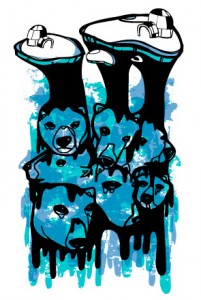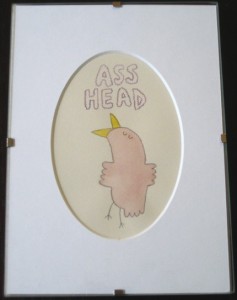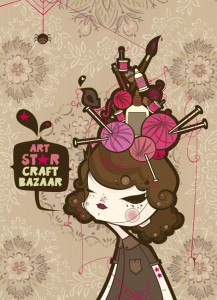The soft strums of an inoffensive acoustic guitar hovered over the booths at the Art Star Craft Bazaar on a correspondingly pleasant day at Penn’s landing. I have noticed, for a few years now, an upsurge in crafting as a popular cultural phenomenon. Its pervasiveness has resulted in communities of both male and female crafters all over the country who unabashedly enjoy and, more importantly, make a living off of the goods that they create. I came to the Art Star Craft Bazaar (it does have the word “Art” in it, after all) to see how individuals are harnessing their creativity to make, sell, and purchase goods.
I hate to sound trite and bring up more impacts of the recession, but the booths did not reflect any sign of economic crisis and penny-pinching. It was rather the opposite. Brainstorm, a print and design team of recent art-school grads Jason Snyder and Briana Feola, had a flurry of activity around their booth. “Our prints are flying out of here,” said Snyder over his shoulder as he slid a piece into a protective sleeve for a customer.

One of the major selling points of buying handmade, as one young man pointed out to me as he thumbed through Brainstorm’s prints, is the unique quality of the items. Buying from an individual rather than a mainstream commercial store justifies the spending.
I met artist and seller Andrew Zangerle because I couldn’t help but notice his booth. Two signs in front of his booth read “Come over here!” and “Buy some art!” He later wrote to me that someone had bought the signage.

Zangerle is a UArts graduate who moved back home to Rochester, NY after matriculation in 2002. He had recently returned to Philadelphia “not quickly enough” and that day was selling small figurines (“dolls”) made of painted Sculpey ( $20 each) and small framed 5×7 watercolor drawings that combine a cute, simplified image with a seemingly unexpected phrase underneath, also for $20.

A large amount of sales occur online. Etsy, a social networking site/online craft bazaar, launched in 2005. In the month of February 2009 they reported 690,000 items sold for $10.3 million, with 132,000 new members. That’s in one month. A recent article on the Etsy website gives tips from fifty Etsy sellers who have now given up their day jobs because they make their living off of their Etsy store.
Matt Stinchcomb, the Vice President of Marketing at Etsy (and former singer/guitarist of the French Kicks) quoted some interesting statistics, “The average Etsy user is 32. Our users are mostly college-educated, tech savvy—I think about 50% or more are active bloggers or social network users—and women from the US.”
I cannot help but notice uniformity, both on Etsy and particularly at the Art Star Craft Bazaar. I’m not just referring to the items. It is a craft fair and one expects to find jewelry and screenprinted t-shirts, though I did see a plethora of skull-patterned baby clothes, one-eyed monster dolls, even wheat beer-infused soap. The overarching aesthetic is eerily homogeneous: animal and nature-based imagery, highly stylized in shades of pastels and warm browns, and above all, an embrace of cuteness combined with a little bit of twisted nastiness, in a Yoshitomo Nara/Edward Gorey/Henry Danger way. Like the style or not, it clearly has a broad appeal.

Both Fred Greenblatt and Ellen Gilman came from New York specifically to shop at Art Star (though afterwards they asked for directions to Old City). Greenblatt was sitting on a bench holding the beginnings of a sweater, “it’s for my grandchild” he explained, as he carefully curled the soft umbilical cord of the yarn. Gilman offered an immediate reaction to the crowd: “I’ve never seen so many tattoos in my life! Look at that woman behind you” she pointed to one woman with an octopus-emblazoned arm, “she’s pushing a baby carriage!… And there’s another one!” She was right: the majority of crowd looked the same, 20 and 30-somethings in vintage clothes, many of the young men with ironic moustaches (“face hobbies”).
Greenblatt and Gilman’s largest complaint, in the end, was the high price of the items. “In New York you’d be able to buy a silkscreened t-shirt for $10-$15. The t-shirts they were looking at were priced at $18-$25. Another complaint issued by Greenblatt was the lack of men’s items, considering that Father’s Day is around the corner (June 21) “I wanted to buy some men’s jewelry, but there’s none here.”
Although the items for males was lacking, the number of men selling the items seemed to match evenly with the number of female sellers. Perhaps this is an indicator that feminism has succeeded: it’s no longer homely, boring, and feminine to participate in traditional crafts. In fact, they have made crafting trendy again, and take what they do quite seriously. The dozen or so surprisingly slick business cards I was given serve as testimony. It was interesting to witness a manifestation of the cottage-industry crafting phenomenon through the Art Star Craft Bazaar. These creative people have found a way to achieve a sort of economic independence by making a living off of what they enjoy doing: making things, even if they all sort-of look the same.








